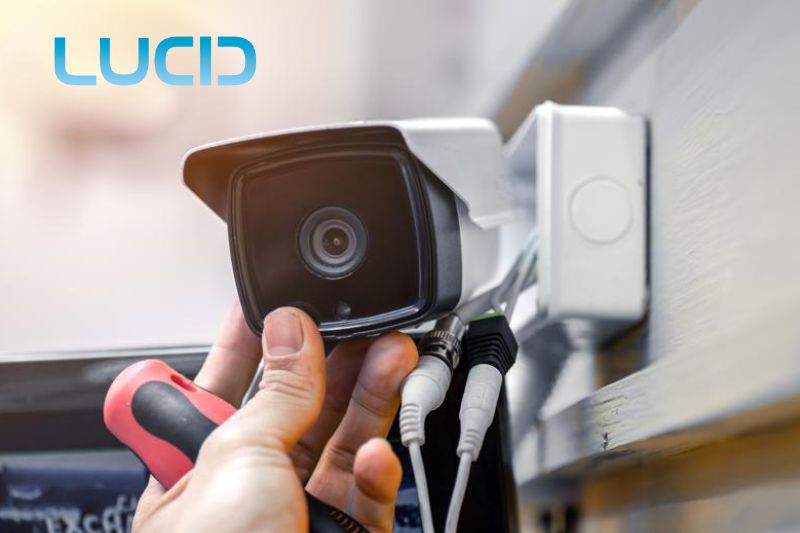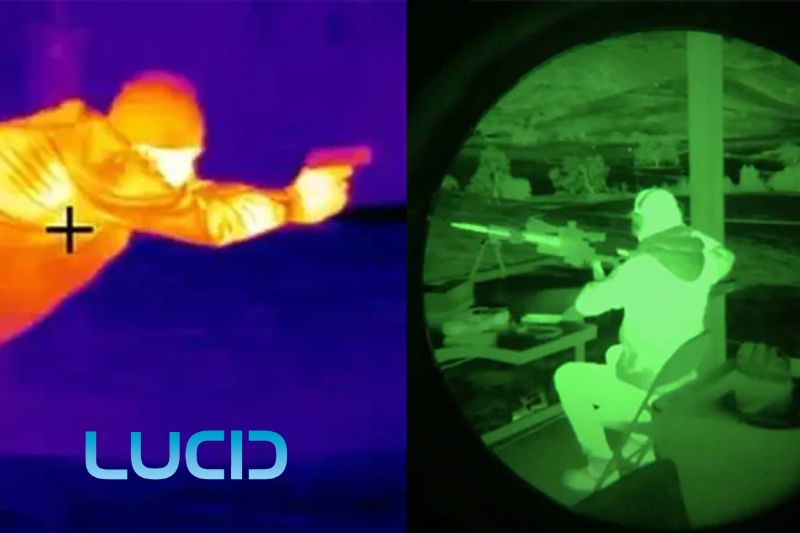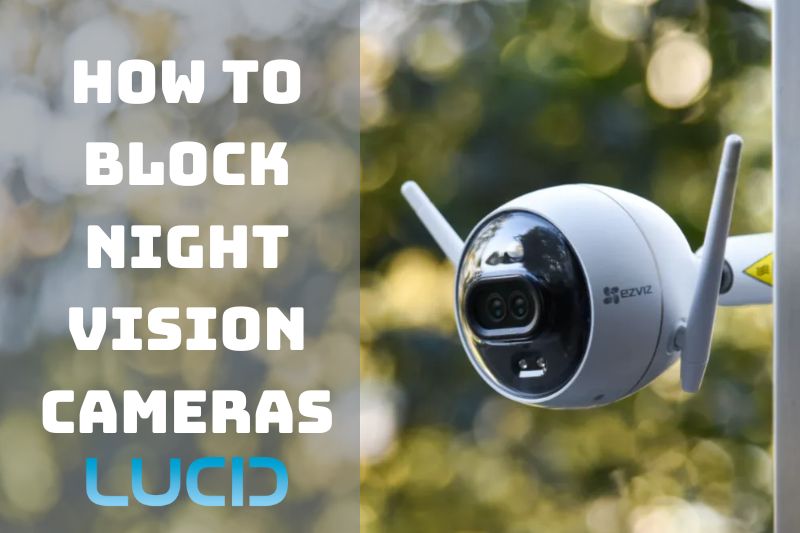People use special cameras that can see in the dark to keep their homes and businesses safe. But sometimes, bad people can hack into these cameras and watch you without you knowing. It’s important to know how to block night vision cameras to proctect your privacy safe.
In this article, Lucidcam will discuss the various methods available to ensure your security and privacy when using these surveillance devices.
Table of Contents
Can You Block Infrared Cameras?

Infrared cameras can see things that give off heat, and they’re used for lots of different things like security and medical imaging. It maybe difficult to stop these special cameras from watching you because it depends on what type of camera it is and how you try to stop it
Most things won’t completely block the heat that the camera can see, but there are some special materials like mylar film and ceramic tiles that can help reduce what the camera sees.
Sometimes, people can also use tricks like hiding or changing the temperature of things to make them harder for the camera to see.
Remember, sometimes cameras are used by the police or for national security, and it might not be okay to try and stop them.
Why It’s Important to Block a Night Vision Camera

Night vision cameras are used for watching things in the dark, like for security. But sometimes, people use them to spy on others without their permission. This is not okay!
Try to cover the night vision camera if you suspect someone is watching you with one so they can’t see you any longer. This can protect your privacy and prevent individuals from spying on you without your consent.
How to Block Night Vision Cameras

Blocking a night vision camera is a relatively simple steps and can be done in several ways. Here is a guide on how to block a night vision camera:
- Identify the location of the camera. Most night vision cameras are small and difficult to spot, so you’ll need to look for small red or green lights that show they’re there.
- Cover the camera lens. One of the easiest methods to block a night vision camera is by covering the lens with a piece of tape or adhesive material. This will prevent the camera from capturing images or videos. Make sure to use a material that is opaque and completely covers the lens, as some cameras may be able to see through thin or transparent materials.
- Use a camera-blocking device: If you’re concerned about how well tape or glue will work, you can buy a camera-blocking gadget online or at a store near you. These gadgets are very good at blocking the lens of night vision cameras because they were made to do so. Some stopping devices use infrared or laser technology to stop the camera from taking clear pictures or videos.
- Use a bright flashlight. You can momentarily blind the camera with a powerful spotlight if you think someone could be watching you with a night vision device. Shine the flashlight directly at the camera lens, which will disrupt the camera’s ability to capture clear images or videos. This method can be helpful because it does not ask for you to physically obstruct the camera and allows you to move about freely.
- Seek professional help. It’s crucial to get expert assistance if you think someone could be violating your privacy by utilizing a night vision camera. Contact the authorities or a security expert who can help you identify and block the camera effectively. They might be able to utilize specialist tools to find hidden cameras or give you advise on how to safeguard your privacy going forward.
Thermal vs Infrared: What is the difference?

People often use thermal imaging and infrared technology equally, but there are some important differences between the two.
The heat that an object gives off is picked up by thermal imaging technology, while infrared technology picks up the heat that an object gives off as electromagnetic energy.
Infrared light is used by thermal imaging clothing cameras to make a picture of the temperature of an item or scene. This technique monitors the amount of heat an object emits in order to determine its temperature. This makes it feasible to notice temperature disparities.
Thermal imaging is often used in the workplace to do things like find hot spots in electrical systems or watch for signs that equipment is getting too hot.
On the other hand, infrared technology uses the electric energy that objects emit to locate them. By capturing the infrared light that an item emits and converting it into an image, infrared cameras capture objects.
This technology is often used for security purposes, like keeping an eye on attackers or finding things when there isn’t much light.
Overall, both thermal imaging and infrared technology are useful tools that can be used in many different ways. It’s crucial to understand their differences even if they may appear to be same in order to pick the technology that best suits your requirements.
The right thermal or infrared technology can help you do your job better and faster, whether you’re keeping an eye on industrial tools or making sure a building is safe.
FAQs

Is there a camera jammer?
Yes, There are things called camera jammers that can stop wireless cameras from sending pictures or videos. They make the cameras not work by messing with their signals.
But you need to know that using camera jammers might not be allowed in some places, and they can also make other electronics not work right.
Can night vision see through clothes?
Night vision technology is designed to detect thermal radiation emitted by objects, not to see through solid objects like clothing.
However, some night vision cameras such as thermal Go light may be able to detect the heat signature of a person’s body underneath their clothing, particularly if they are wearing tight or thin clothing.
This is because clothing can trap heat and prevent it from dissipating, creating a distinctive body heat signature. However, this type of imaging is typically not detailed enough to allow for the identification of specific body parts or features.
How to hide from thermal imaging?
To hide from thermal imaging, you can use materials that are good at stopping or soaking heat and that don’t let infrared light through. For example, wearing dark, loose-fitting clothes made of cotton or other natural fibers can help lower your body heat signature by letting heat escape from your body.
You can also stop infrared cameras with an anti-thermal blanket or insulation material to make a thermal barrier that keeps heat from leaving. Another option is to use natural covers, like trees or bushes, to make a shield that the thermal camera can’t see through.
Does mud hide heat signature?
Yes, mud can be effective at hiding a heat signature by creating a layer of insulation that prevents heat from escaping. Applying a layer of wet mud to your body or clothing can help to reduce your thermal signature, as the mud will absorb and dissipate heat.
It’s crucial to keep in mind that this approach might not always be practicable or successful since the mud can dry up too fast or draw unwelcome attention.
Can an infrared camera see through curtains?
Infrared cameras can see the heat that objects give off, but they can’t always see through things like curtains or walls. If the material is thin or semi-transparent, like a sheer curtain, the camera might still be able to detect the heat signature behind it.
But, if the material is thicker or more opaque, like a heavy drape or a wall, the camera won’t be able to see through it. So, it’s harder for the camera to detect the heat behind these materials.
What is IR-reducing clothing?
IR-reducing clothing is made to cut down on the amount of infrared radiation (IR) that gets through the fabric and hits the skin of the user. Infrared radiation is a type of electromagnetic energy that comes from the sun and some other things and machines.
How to hack neighbors security cameras
it is illegal and unethical to do so. Hacking into someone’s security cameras without their consent is a violation of their privacy and can lead to serious consequences. It’s important to respect the privacy of others and to find legal and ethical ways to resolve any disputes or concerns you may have.
Conclusion
In conclusion, it is important to know how to block a night vision camera in order to ensure the security of our property, privacy, and safety. By understanding the differences between thermal and infrared cameras. We can more effectively protect ourselves from unwanted surveillance.
Furthermore, with the right infrared blocking material and techniques, blocking a night vision camera is relatively easy and can provide peace of mind in knowing that your property is safe and secure. Taking proactive steps such as these will better protect us against any unwelcome eyes watching our home or business. Thank you for reading!
